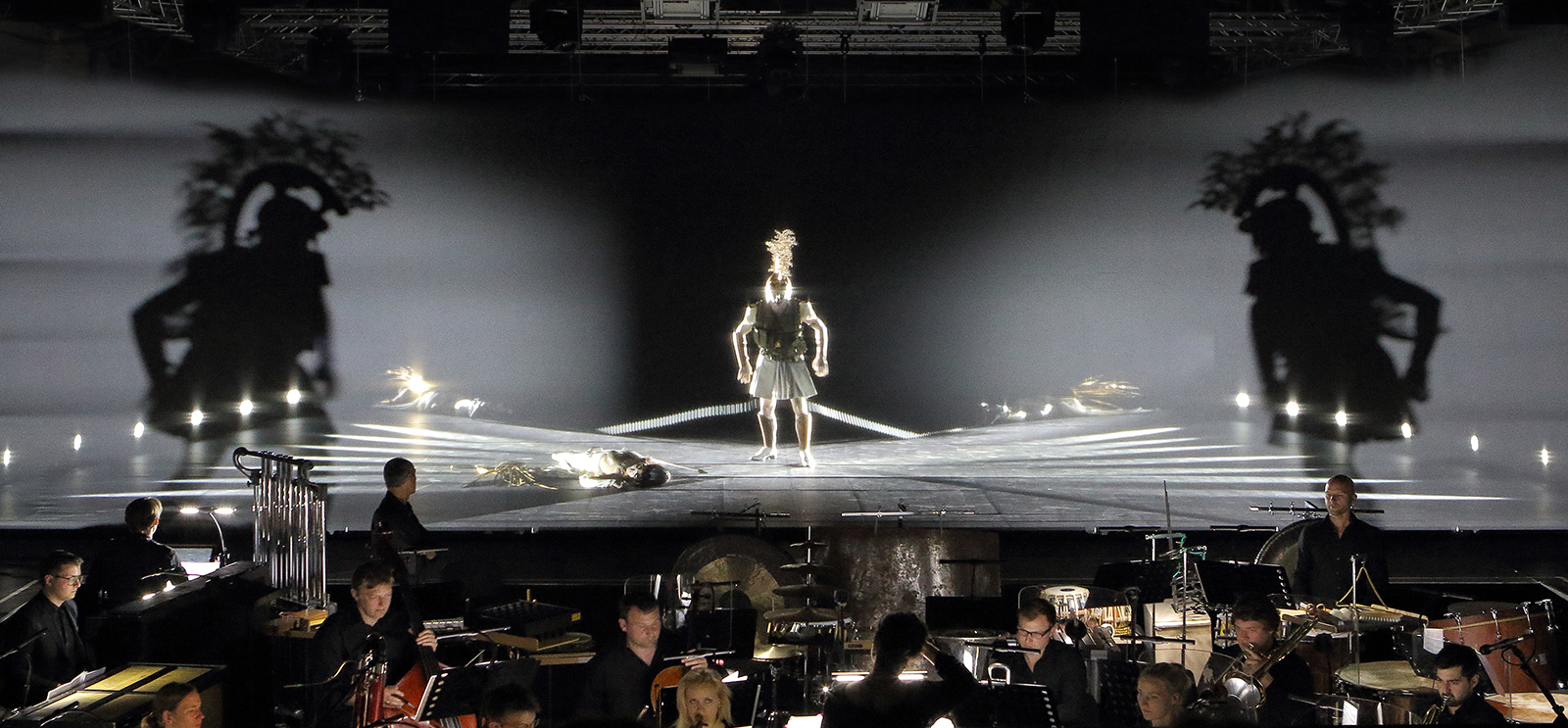
Reviewers called Mauerschau “intense,” “fascinating,” and “dazzling.” (Photography by Wilfried Hösl)
In her critically acclaimed opera, Amy Stebbins, AM’14, tackles the timeless problem of war.
“Was siehst du?”
“What do you see?”
It’s a question that pulses throughout the new German-language opera Mauerschau, which premiered June 29, 2016, to impressed audiences and critics alike. One reviewer proclaimed the piece the “incontestable ornament of the Munich Opera Festival.” With direction and libretto by University of Chicago graduate student Amy Stebbins, AM’14, Mauerschau transforms Heinrich von Kleist’s play Penthesilea (1808) into an opera exploring the chaos of war.
In Kleist’s tragedy, Penthesilea, the Amazonian queen and dedicated warrior, falls in love with the Greek Achilles, only to kill him through a series of misunderstandings. Kleist’s world is one of muddled truths and misinterpreted motives. No one, not even the leading lovers, can stay clear on who’s fighting who and why. In the end, Penthesilea dies under the weight of what she’s seen and what others have told her she’s done.
Stebbins, a PhD candidate in cinema and media studies and Germanic studies, majored in history and literature as an undergraduate. After college, she worked at several German theaters, including the famed Volksbühne, known for its avant-garde productions. She encountered Penthesilea for the first time in a UChicago seminar taught by Christopher Wild, associate professor of Germanic studies.
The piece is both compelling to scholars and tricky to stage because it uses a technique known as “teichoscopy”—or, in German, mauerschau— which involves directly reporting to the audience on unseen events. (As a practical matter teichoscopy provides a way around scenes that would be difficult to stage, like battles.)
So when composer Hauke Berheide first posited putting Penthesilea on stage, Stebbins had her doubts. “It would be incalculably boring—hours of actors recounting events that the audience is unable to see.”
But Stebbins and Berheide realized the concept could work as an opera, which had the potential to open Penthesilea to fresh possibilities.
And Kleist’s themes of conflict and confusion had begun to seem ever more relevant. At the time, Russia was in the headlines for its forceful annexation of the Crimean peninsula. “Neither the political leadership nor those actually living in Ukraine seemed to know what was really going on,” says Stebbins. Then the Islamic State began gaining ground, bringing more global uncertainty. “The facts were changing every day,” she says.
This—the elusiveness of facts, the obscurity of truth—is central to Mauerschau. Stebbins and Berheide knew what problems they wanted to address. How do we navigate war and international relations in a world where information is so difficult to verify, let alone comprehend? And how, they wondered, can citizens in a democracy make decisions about their country if political leaders and institutions don’t keep the public informed?
It’s a problem that goes back centuries, Stebbins says. “There’s a lot of discussion about how recent technological developments have created a new problem for truth in war reporting,” she says. “But if you look back even to the Greeks, this problem of figuring out what was actually happening was just as prevalent.”
Stebbins knew that the heightened language and tragic nature of Penthesilea would translate well to opera. In the scene where the queen comes to terms with what she’s done, “it would be a challenge not to identify with the sense of total disorientation that she’s experiencing,” Stebbins says. She stayed true to her source material, employing the same dramaturgical tool from which Mauerschau takes its name. The opera’s messenger character weaves in and out of the piece, providing both the audience and the opera’s characters with new information—information that often conflicts with what is seen.
Refusing to situate Mauerschau in a singular moment or context, Stebbins incorporated a patchwork of texts in her libretto. The piece opens with audio of former US secretary of state Colin Powell’s 2003 remarks to the United Nations on alleged weapons of mass destruction in Iraq, as a projected photo of a cannonball-riddled road taken during the Crimean War fades to black. She also sprinkled the libretto with lines from writers and thinkers including Friedrich Nietzsche and the memorable “known unknowns” of former US secretary of defense Donald Rumsfeld.
In the end, Mauerschau doesn’t present an obvious solution to the problem of unintelligible war—a solution Stebbins thinks may not exist. But that was never the point. For her, it’s not the job of art to “articulate an answer to a societal problem.” Instead, she’s offering what she describes as “a kind of critique ... in the form of a question.”
